The Art of Chen Tinglan (Chan Ding-Lan 陳汀蘭)

Patrick Siu Chinese Calligraphy & Landscape Painting 蕭燿漢談書畫
Chinese calligraphy and landscape painting

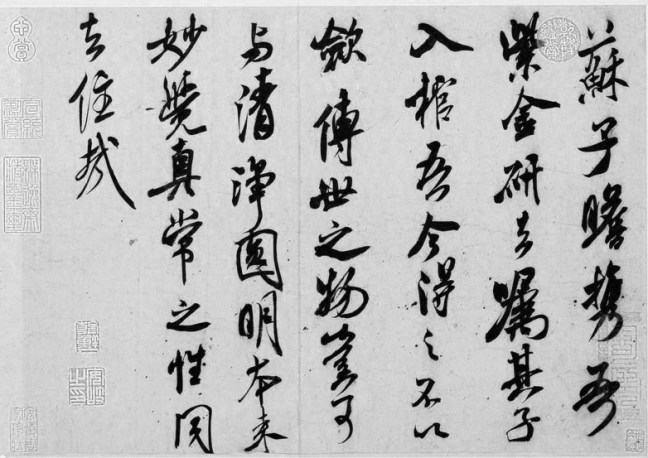
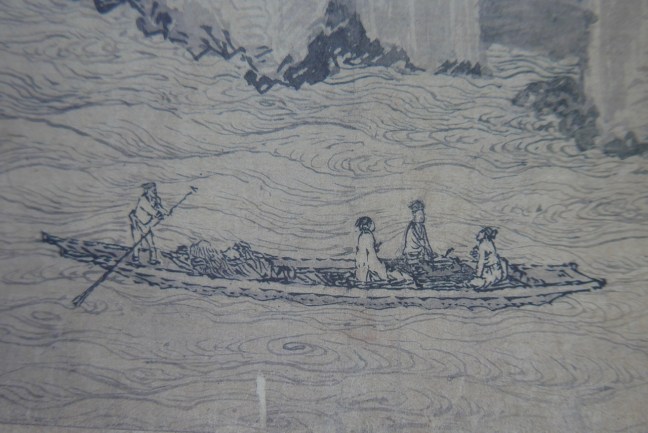

Opening hours : Monday to Saturday, 10 am to 1 pm; 1:30 pm to 4 pm (Sundays closed)
Venue : Chinese Cultural Centre, Street Level, 799 Pacific Highway, Chatswood,
Corner of Victoria Avenue and Katherine Street, near Chatswood Railway Station
For more information, please visit:
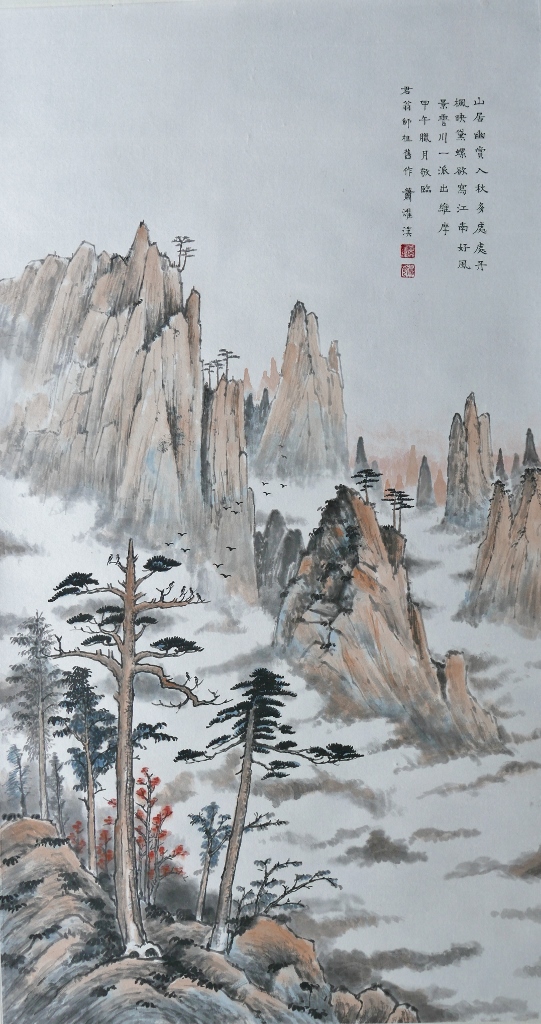








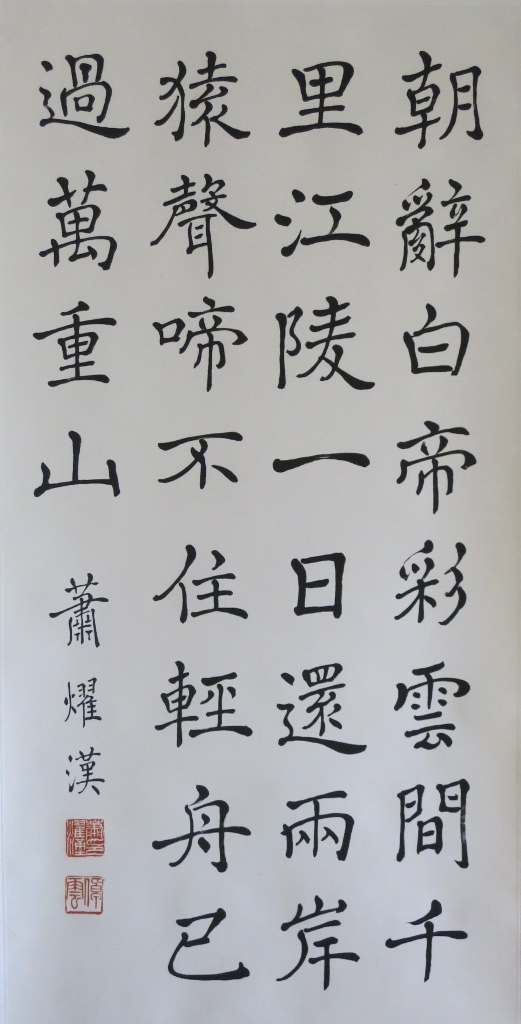
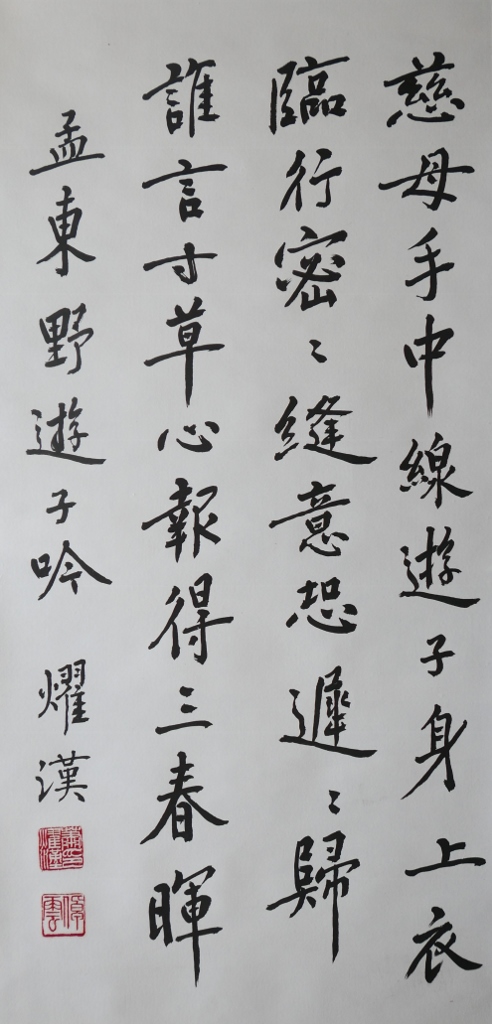
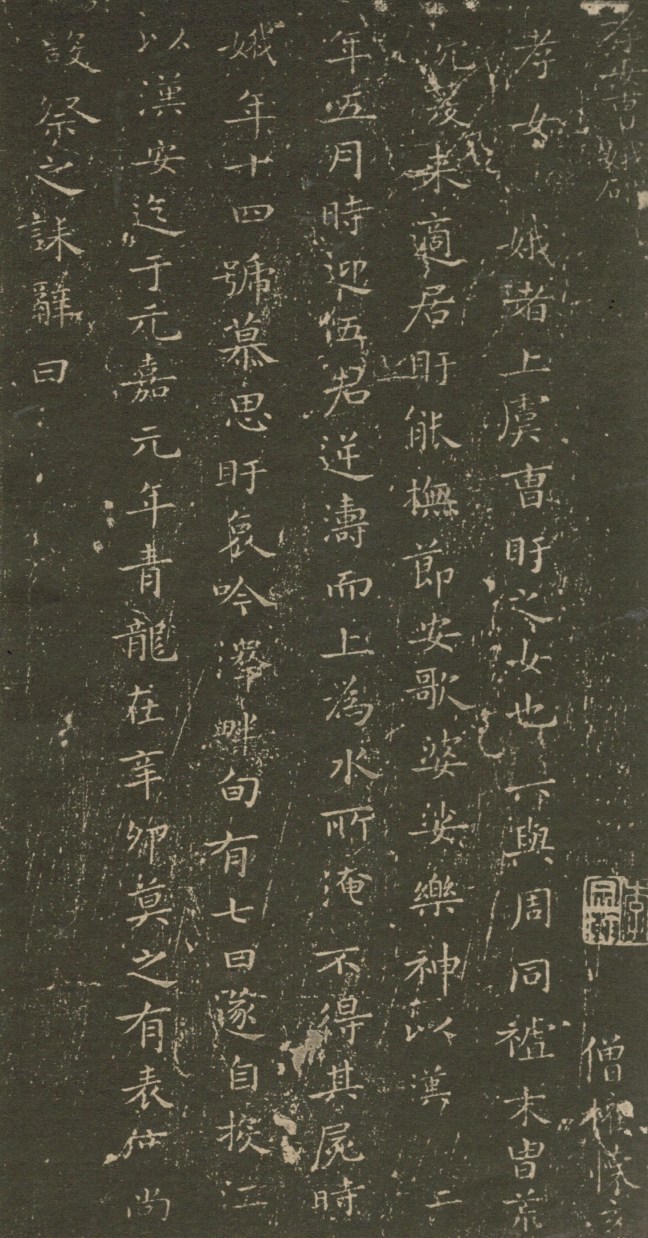
(碑文) 孝女曹娥者,上虞曹盱之女也。其先與周同祖,末胄荒流,爰來(茲)適居。盱能撫節安(按)歌,婆娑樂神。漢安二年五月五日迎伍君,逆濤而上,為水所淹,不得其屍。時娥年十四(歲),號慕思盱,哀吟澤畔,旬有七日,遂自投江死,經五日抱父屍出。以漢安迄于(於)元嘉元年青龍辛卯,莫之有表。度尚設祭誄之。
辭曰:伊惟孝女,曄曄(奕奕)之姿。偏其反而,令色孔儀。窈窕淑女,巧笑倩兮。宜其室家,在洽之陽。大禮未施,嗟喪(傷)慈父。彼蒼伊何?無父孰怙!訴神告哀,赴江永號,視死如歸。是以眇然輕絕,投入沙泥。翩翩孝女,載沉載浮。或泊洲渚,或在中流。或趨湍瀨,或逐波濤。千夫失聲,悼痛萬餘。觀者填道,雲集路衢。泣淚掩涕,驚動國都。是以哀姜哭市,杞崩城隅。或有尅面引鏡,剺耳用刀。坐檯待水,抱樹而燒。於戲孝女,德茂此儔。何者大國,防禮自修。豈況庶賤,露屋草茅。不扶自直,不斫自雕。越梁過宋,比之有殊。哀此貞厲,千載不渝。嗚呼哀哉!
銘曰:名勒金石,質之乾坤。歲數歷祀,立墓(廟)起墳。光于(於)後土,顯照天人。生賤死貴,義之利門。何悵華落,飄零早分。葩艷窈窕,永世配神。若堯二女,為湘夫人。時效仿佛,以昭後昆。
Cao E (曹娥)
A young girl called Cao E (曹娥)(130–143CE) was a native of Shangyu (上虞)(today 浙江紹興 Shaoxing of Zhejiang). She was the daughter of Cao Xu (曹盱) . Cao Xu was a shaman who was talented in singing and dancing. In 143 CE, while Cao Xu was presiding over a ceremony on a boat commemorating Wu Zixu (伍子胥) during the Duanwu Festival, a sudden strong gale shook the boat and he fell into the river and was drowned. Cao E was overwhelmed with grief. She, in an act of filial piety courageously decided to search for her father along the river for 17 days but could not find the body of her father. Cao E eventually dived into the water. After 5 days, she emerged holding her father’s body. Though dead, her face appeared as if she was alive. People in Zhejiang (浙江) commemorated Cao E for her filial piety.
Bibliography and further readings :
宋搨越册楷帖十一種 (臨川李氏藏) (1937) 文明書局, 中華書局
https://zh.wikipedia.org/wiki/%E6%9B%B9%E5%A8%A5%E7%A2%91
http://baike.baidu.com/view/348160.htm?fr=iciba#7 (有注釋)
http://www.baike.com/wiki/%E3%80%8A%E6%9B%B9%E5%A8%A5%E7%A2%91%E3%80%8B

林逋《乘公橋作》:
偶錄和靖先生詩 戊申 (1968) 冬 黄維琩 (白紋方印: 欣園)
(語譯) 在夕陽下山峰、大橫石和樹頂都染上了紅色, 數座大漁網的倒影在水中呈現。
我記得這是江南風景的特色, (這種如詩如畫 的美景) 好像我以前看過的巨然大屏風名畫在我眼前。
The poem depicts an evening scene with the hill tops, rocks and tree tops bathed in red in the setting sun. There were a few panels of fishing nets with reflections in the water. The scene reminded me of Jiangnan and was akin to the big screen landscape painting of Ju Ran.
榜 – 划船用的工具, a paddle for rowing a boat, in the poem 榜 may mean panels (of fishing net)
魚罾 – 漁網的一種。俗稱扳罾﹑攔河罾, a fishing net
江南 – Jiangnan, – a geographic area in China referring to lands immediately to the south of Yangtze River, including the southern part of the Yangtze Delta.




Lin Bu (林逋)( c967- 1028) also known as Junfu (君復) and Hé Jìng Xiānshēng(和靖先生) was a Chinese poet during the Northern Song dynasty. He was a native of Qiántáng (錢塘)(today Zhèjiāng Hángzhōu 浙江杭州). Lin was one of the most famous verse masters and poets of his time. He lived in solitary by the West Lake (西湖) in Hangzhou (杭州) for much of his later life. An old plum tree and a crane kept him company. Lin regarded the old plum tree as his wife and the crane as his son (梅妻鶴子). He writings were collected in Lín Héjìng Shī Jí (林和靖詩集).
Professor WONG Wai Cheong (黃維琩教授) (1902 – 1993), zi (字) Xīn Yuán (欣園), hao (號) Zǐ Shí (子實) was a well-known Chinese literature scholar and Calligrapher. Coming from an educated family, Mr Wong graduated from Guangzhou Zhongshan University (中山大學) with degrees. He was both a lawyer and a certified accountant and held senior positions in the Guangzhou government. Mr Wong migrated to Hong Kong around the 1950s and taught at various secondary and tertiary education institutions. His contributions to Chinese education were significant. He had publications of his own poems and lecture notes.
This piece of calligraphy was executed on a hand-held fan (扇子 or 摺扇). It is used to induce an airflow for cooling or refreshing oneself. The double layer of paper (扇面) is mounted on slats which revolve around a pivot so that it can be closed when not in use.
Further readings :
http://blog.sina.com.cn/s/blog_4b8dbcd30100u7l8.html
http://big5.dushu.com/showbook/101048/1031784.htm
https://zh.wikipedia.org/wiki/%E6%9E%97%E9%80%8B
http://www.lnmuseum.com.cn/huxing/show.asp?ID=7095
http://www.360doc.com/content/13/0424/12/10983756_280577684.shtml ( 五代董源夏景山口待渡图卷)
http://en.wikipedia.org/wiki/Juran_(painter)
https://zh.wikipedia.org/wiki/%E6%9E%97%E9%80%8B
http://www.lnmuseum.com.cn/huxing/show.asp?ID=7095
黄維琩教授書法選輯 (1994) 鑑古書學社

千里楓林煙雨深,無朝無暮有猿吟。
停橈靜聽曲中意,好是雲山韶濩音。
Giān lǐ fēng lín yān yǔ shēn , Wú zhāo wú mù yǒu yuán yín.
Tíng ráo jìng tīng qū zhōng yì , Hǎo shì yún shān sháo huò yīn.
橈 : 船 boat
好是:真是。韶是舜樂,濩是湯樂。元結有《補樂歌》十首,其八小序說:“大韶,有虞氏之樂歌也。” 又其十小序說:“大濩,有殷氏之樂歌也。” 全句的意思是,這曲子真是雲山之中的韶、濩似的樂曲。
Seals : Wong (Huang) 黃 (朱紋), Xīn Yuán zhǎng nián 欣園長秊(年) (朱紋)
This is the third of the series of five Āi nǎi (欸乃) poems. They were written in 767CE.
Āi nǎi (欸乃) was some folk songs sang by boatmen / fishermen in the water among Húnán (湖南), Guǎng Xī (廣西) and Guì Zhōu (貴州).
欸乃:拔船的聲音。一說是湖南、廣西以及貴州三省交界廣大地方山歌末尾時用高亢嗓音喊唱出來的一聲號子。元結自註:“欸乃:棹舡之聲。” 欸乃曲:即“山歌”或“船歌”的別稱。
The poet was on his boat journey sailing upstream from Zhǎng Shā (長沙) back to Dào Zhōu (道州). The maple forests by the side of the river are picturesque. In addition to the sounds of monkeys in the mornings and evenings, the singing of the boatmen echoed among the poetic scene. However, the water in the river was rapid and the journey was rough. The 5 poems were impromptu work to encourage the boatman to persevere with their heavy work.
Yuan Jie (元結) (719-772), also known as Cì Shān (次山), Màn Láng (漫郎) and Ao Sǒu (聱叟) was a famous poet in the Tang Dynasty. He was a native of Henan (河南). Yuan passed his imperial Chin-shih examination (登進士第) in 753 and was granted some posts in the government. He fought against Shǐ Sīmíng rebels (史思明叛軍) and was promoted to the post of Governor of Dào zhōu (道州刺史). Yuan has many merits. His poems reflect the harsh lives of the people and the evil and corruption of the government. He spoke out for the people. His poems of sceneries (山水詩作) were fresh and innovative. Unfortunately many of his writings have been lost. Scholars in the Ming Dynasty collated his works into Yuán Cì-shān Jí (元次山集).
Professor WONG Wai Cheong (黃維琩教授) (1902 – 1993), zi (字) Xīn Yuán (欣園), hao (號) Zǐ Shí (子實) was a well-known Chinese literature scholar and Calligrapher. Coming from a highly educated family, Mr Wong graduated from Guangzhou Zhongshan University (中山大學) with degrees. He was both a lawyer and a certified accountant and he held senior positions in the Guangzhou government. Mr Wong migrated to Hong Kong around the 1950s and taught at various secondary and tertiary education institutions. His contributions to Chinese education were significant. He had publications of his own poems and lecture notes.
The format of this long and narrow scroll is known as qín tiáo (琴條) or tiáo fú (條幅). The shape looks like a gǔ qin (古琴) hung vertically on a wall.
Further readings :
http://sou-yun.com/PoemBookNav.aspx?b=tshp&d=13&page=2&lang=t
黄維琩教授書法選輯 (1994) 鑑古書學社

游子吟 Yóu Zǐ Yín (Poem of a Wanderer) by Mèng Jiāo (孟郊) (751—814)
慈母手中線, 遊子身上衣。
Cí mǔ shǒu zhōng xiàn, yóu zǐ shēn shang yī.
My loving mother stretches a needle and thread in her hand.
She is making clothes for her departing son.
臨行密密縫,意恐遲遲歸。
Lín xíng mì mi fèng, yì kǒng chí chí guī.
Stitch by stitch, she sews them very tightly,
Fearing that her son will not be back for a long time.
誰言寸草心,報得三春暉。
Shuí yán cùn cǎo xīn, bào dé sān chūn huī.
How could the grateful humble inch-tall grass
Ever repay the nurturing Spring Sun.
Mèng Jiāo (孟郊)(751—814) also known as Mèng Dōng Yě (孟東野) was a scholar and a poet. He was a native of Hú Hōu (湖州) (now Zhè Jiāng 浙江). Mèng suffered from lots of hardship and he did not succeed in his imperial Chin-shih examination (登進士第) until the late age of 46 and been a small official.
Little young grass grows toward the warm spring sunlight. Mother’s love is like the Spring Sun, warm and comfortable but not violently hot. Nothing can repay the love of our mothers. The 42 words poem does not contain the word ‘tears’ but it is deeply moving. It conveys strong emotions.
Further readings :
http://www.baike.com/wiki/%E6%85%88%E6%AF%8D%E6%89%8B%E4%B8%AD%E7%BA%BF (慈母手中线)
http://en.wikipedia.org/wiki/Meng_Jiao

計與足下別,廿六年於今,雖時書問,不解闊懷。省足下先後二書,但增歎慨。頃積雪凝寒,五十年中所無。想頃如常,冀來夏秋間,或復得足下問耳!比者悠悠,如何可言?
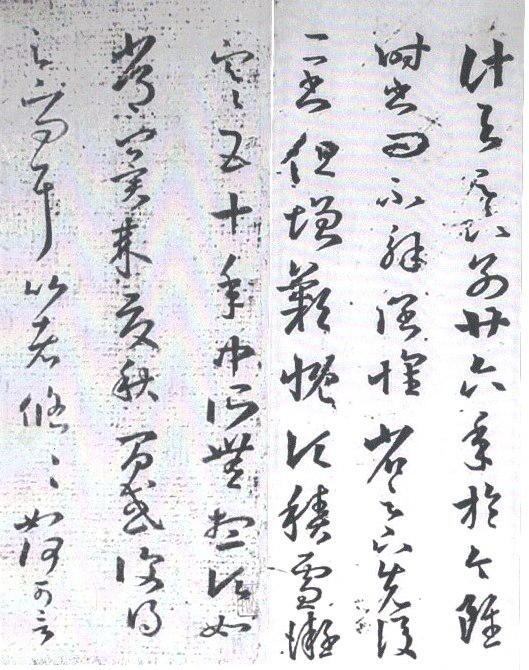
The images of ink rubbings have been photographical modified, with black and white reversed so that the characters are black on a white background.

計與足下別廿六年, 於今雖時書問, 不解闊懷。
Counting back I have not seen you for 26 years. While we write to each other from time to time, I still miss you very much.
省足下先後二書, 但增嘆慨。
After reading your two recent letters, I feel even more sorrowful (in not being able to see you).
頃積雪凝寒,五十年中所無。
Snow has thickly accumulated. (There had been heavy snowfall.) The weather is extremely cold. It has not been that cold for the last 50 years.
想頃如常, 冀來夏秋間, 或復得足下問耳。
I hope you are keeping well. I expect to hear from you sometime next Summer and Autumn.
比者悠悠 ,如何可言。
Time flows on steadily. I do not know what to say about my gloomy feelings.
For further information on Shi Qi Tie, please visit the following webpage.
Cursive script: Shi Qi Tie (The Seventeenth) of Wang Xizhi 王羲之十七帖 (Part 1)

The text: 羲之頓首快雪時晴佳想安善未果為結力不次王羲之頓首山陰張侯
頓首 mean bowing one’s head and is a courteous sign-off of letters. 羲之頓首 means Xizhi bows. 山陰張侯 Zhāng hóu of Shānyīn is the recipient of this letter.
快雪時晴佳。
The snow has fallen for a short time and it is sunny now. ( 剛才下了一陣雪,現在天又轉晴了。)
想安善。
I trust you are keeping well. (想必你那裡一切都好吧!)
未果為結。
I have not finished writing the letter to fully express my thoughts. (沒能照心意把信寫完,表達難以得體。)
力不次。
I felt helpless and inadequate. (心有餘而力不足。) OR I felt weak. I could not express myself probably. I had to stop writing. (體力不繼,表達難以得體,就此停筆。)
At the very end of the manuscript, there is a very small inscription of two characters ‘Jūn qiàn’ (君倩).
The calligraphy of Wang Xizhi was fresh, elegant and innovative.
Please see two more detailed webpages on these two masterpieces by Wang Xizhi.
蔣勳 (2010) 手帖 南朝嵗月, INK 印刻文學生活雜誌出版有限公司 ISBN 978-986-6377-94-5
Ouyang Z and Wen C.F. (2008) Chinese Calligraphy, Yale University Press, ISBN 978-0-300-12107-0